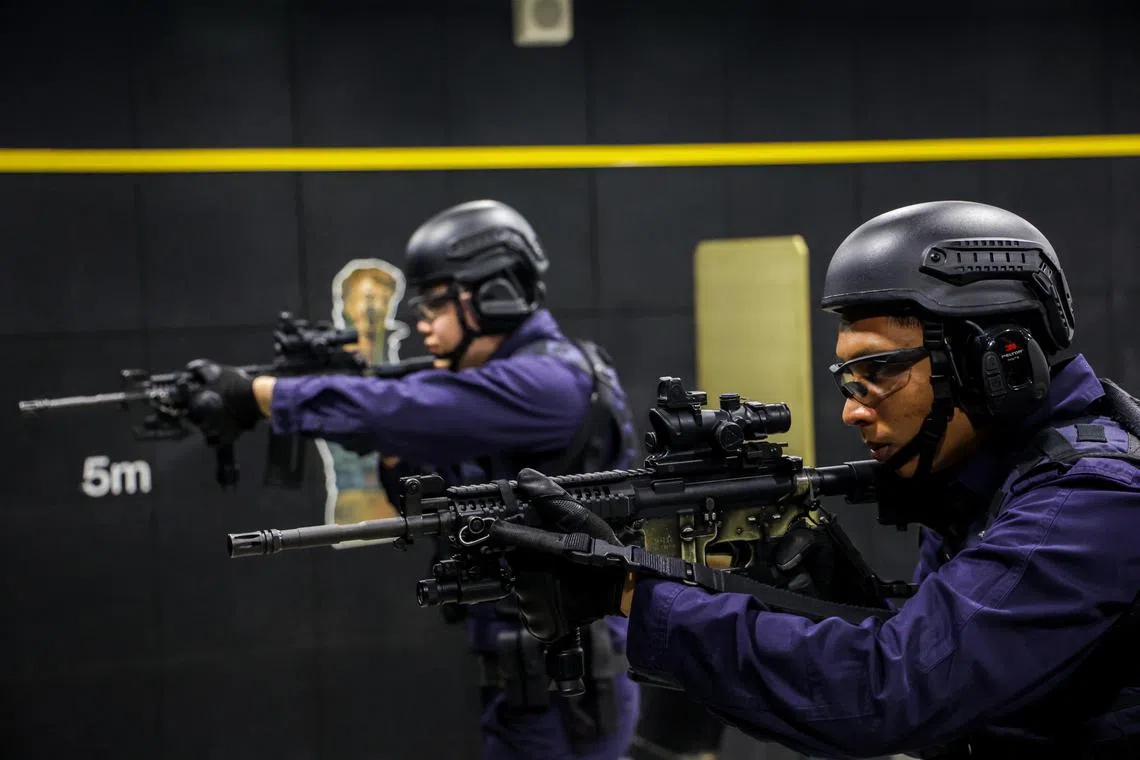Upgraded training facility helps Police Coast Guard stay ahead of new threats
Sign up now: Get ST's newsletters delivered to your inbox
In July, the Police Coast Guard's elite Special Task Squadron staged a live demonstration of a hostage rescue scenario at the revamped Boarding and Search Trainer.
Follow topic:
SINGAPORE – Barrelling through the water on board a third-generation patrol craft, members of the Police Coast Guard’s (PCG) elite Special Task Squadron (STS) zeroed in on a cargo vessel.
The mission, which saw STS officers rappelling onto the deck of the ship, was a demonstration of their vessel-boarding and search procedures at the newly revamped Boarding and Search Trainer (BST) at PCG’s Brani headquarters.
Speaking to the media on July 24, Assistant Superintendent of Police (ASP) Mohammed Khaled Abdul Rahim, PCG’s deputy officer-in-charge of the training centre, said: “To stay ahead of evolving threats and challenges, the BST has been refurbished... to provide officers with realistic training in a controlled environment.”
A PCG spokesman said the new threats could involve technological developments such as the use of unmanned vessels for smuggling or other criminal purposes.
Built in 2006, the BST completed two years of major upgrading works in March 2022. Designed to resemble a cargo vessel, the facility has an indoor firing range, areas to practise methods of entry and tactical procedures, as well as a close-quarters battle area.
During a media tour of the facility, officers simulated a hostage rescue in the close-quarters battle area by neutralising a rogue gunman. They had to tackle steep steps and a narrow corridor which replicate the space limitations in most vessels.
The live-firing area is mostly modular by design, allowing trainers to set it up differently for each training session, with improved ballistic protection allowing for the use of handguns, shotguns and rifles.

Police Coast Guard officers demonstrating a live firing exercise in the new 25m indoor range on July 24.
PHOTO: LIANHE ZAOBAO
Thunderflashes and stun grenades can also be deployed.
The new facility features a four-lane, 25m indoor firing range for tactical firearm training. Officers can practise neutralising threats from the front, with targets also appearing on their left and right.
A central control system can simulate various lighting and sound configurations, including shooting in pitch-black darkness.
The media tour concluded at a 10m-deep tactical pool, with a demonstration of the confidence jump that is a rite of passage for PCG officers.

A 10m-deep pool used for the confidence jump that is a rite of passage for officers.
PHOTO: LIANHE ZAOBAO
The pool also allows the STS to conduct underwater and dive training, including a simulator that can replicate a boat-capsize situation.
ASP Khaled said the PCG will continue to deter crimes within Singapore’s territorial waters, which have seen more armed sea-robbery incidents.
There was a 41 per cent increase
A total of 55 incidents occurred in the Singapore Strait in 2022, representing 65 per cent of the total number of incidents in Asia, according to the organisation’s annual report.

